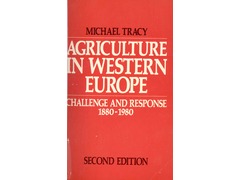Britain
Documents from [1100] to [1939]Identity Statement
5 files
Carr, Mary
Content and Structure
British agriculture underwent a great transformation from feudal times to the nineteenth century, from the medieval open fields to enclosure with a structure of large, consolidated farms. The peasant became non-existent, with instead farm labourers taking their place. With the increase of new technology, productivity increased, the agricultural population dropped and food imports rose.
The industrial revolution created the climate for change and improvements in British agriculture, farming became intensive and maximum food output was encouraged to feed the growing urban population. In fact British agriculture in the nineteenth century was recognised as being the best in the world. In the 1840's there was a strong campaign for a repeal of the Corn Laws' so as to put an end to the fluctuating price of wheat, the campaign was successful and the Corn Laws' were repealed in 1849, this law was the first of many which made Britain a Free Trade country. Despite 30 years of crisis in agriculture and depression which followed, Britain remained unprotected despite strong lobbying by protectionists, after 1897 Britain re-emerged from this crisis.
Other developments in agriculture in the period were the creation in 1889 of the Board of Agriculture on the recommendation of the Royal Commission, established to investigate the causes of the crisis in agriculture. The first colonial conference was held in London in 1887 which led in 1902 to the passing of a resolution on Imperial Preferences which created a kind of commercial union between the countries in the Empire. In 1906 a "Tariff Commission", as it was known produced a report on agriculture which advocated import duties on agricultural products, this movement however failed due to the Liberal Party's opposition.
The depression in agriculture in Britiain from the 1870's to the 1890's also spelt the deathknell for the landed interest in agriculture. Therefore, there emerged smaller farms and a smaller farming population by the end of the depression. By the outbreak of the war in 1914, there were no plans for an increase in agricultural production this changed as the war campaign continued and by 1918 extensive control was established over food supplies. This ended the "laissez-faire" attitude to agriculture, the problem however lay in the question of how agriculture should be managed during peace-time. In the absense of protection measures, the crisis which began in 1929 had a huge effect on British agriculture and the Government was forced to establish emergency measures to deal with the crisis which were abandoned in 1932 with the Import Duties Act. But there remained the problem of the Empire and Imperial Preferences (Ottawa Agreements Act 1932), which led to the introduction of a series of measures - subsidies, marketing schemes, import restrictions to aid farmers, yet there was no definitive policy as such as they were applied piecemeal. Tariff negotiations with other countries were also initiated in the 1930's, the most important being with the US.
As an overall result of the intervention measures taken, prices remained low and the cultivation of wheat grew in particular, agricultural wages remained virtually constant even during the crisis, however the number of farmers working the land dropped considerably. There was also a switch from reliance on food imports from third countries in favour of the Empire.
Conditions of Access and Use
Allied Materials
Notes
See Michael Tracy's book: Government and Agriculture in Western Europe 1880-1988, 3rd ed. (1989)
